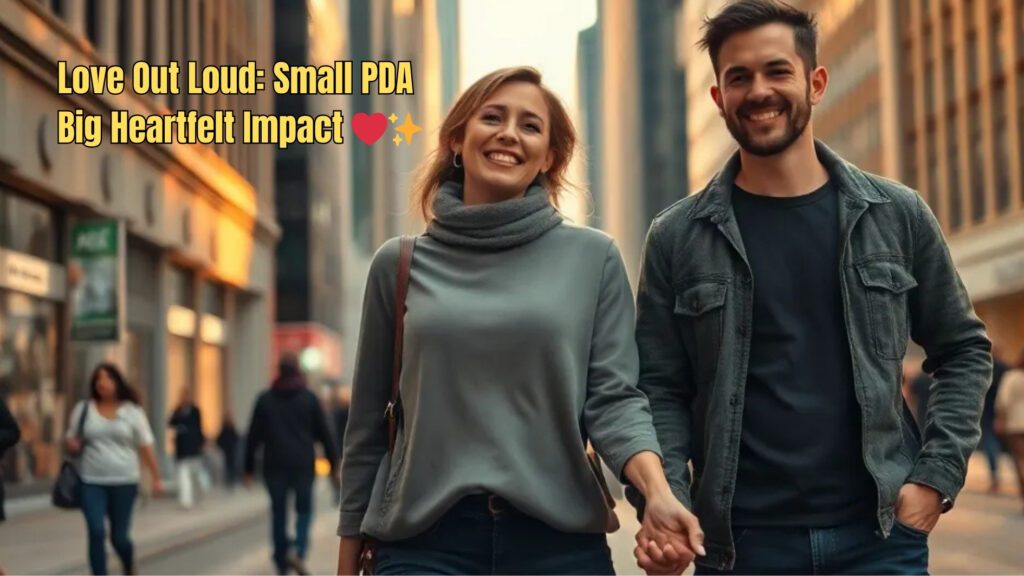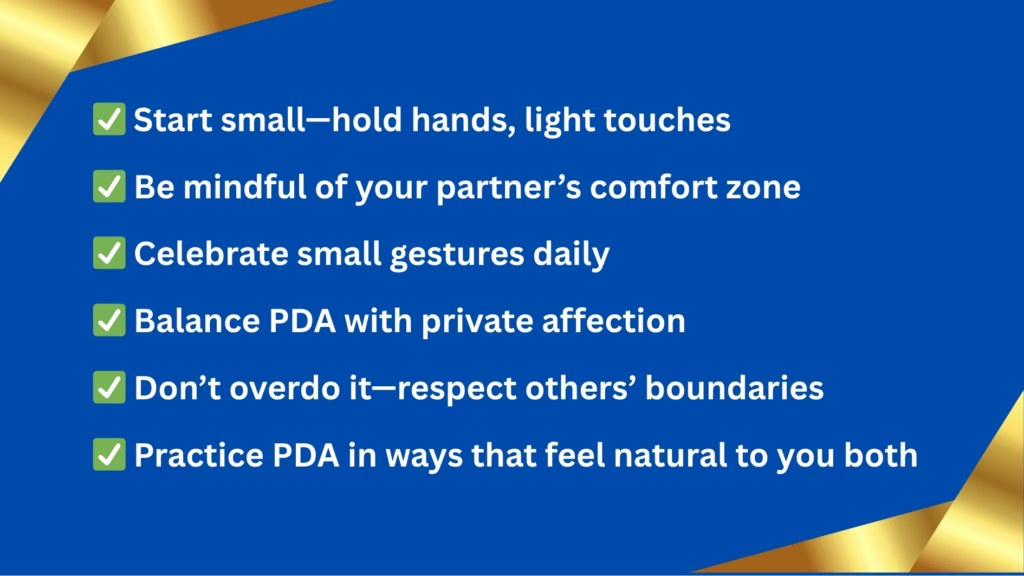The term “what is PDA in relationship” generally arises when couples are unsure of how much public love is appropriate or inappropriate. Public Display of Affection, or PDA for short, includes both tiny and large actions such as holding hands, hugging, kissing someone on the cheek, or even a consoling touch in public. Many relationship experts think that true PDA can be a quiet language of love that strengthens the emotional link between lovers, despite the fact that other people may find it flashy.

Why PDA Matters in Today’s Fast-Paced World
Real-world connections are more valuable in this era of digital ties. Let’s examine why PDA promotes security and trust in relationships rather than only being a means of displaying off.
1. Strengthens Relationship Security
The Power of Small Gestures
Real-life example:
Imagine Sarah and Alex at a local farmer’s market in Austin, Texas. As they walk, Alex reaches for Sarah’s hand, giving it a gentle squeeze. To the world, it’s a tiny moment. But for Sarah, it’s a subtle reassurance: I’m with you. I see you. I choose you.
Relationship coach Dr. Emma White says,
“A brief touch in public can validate your partner’s importance, making them feel secure in the relationship.”
Key Takeaway:
PDA tells your partner—and the world—that your relationship is something you’re proud of.
2. Boosts Emotional Connectivity
PDA as a Language of the Heart You’re doing more than simply showing your sweetheart physical affection when you lean in to give them a quick forehead kiss at your neighborhood café in Berlin. You’re stating that I’m completely present here with you.
Recent research from the Journal of Social and Personal Relationships (2024) reveals that couples who regularly express PDA report higher levels of emotional intimacy.
Case Study:
A couple from Melbourne, Australia, shared that their regular walks, complete with playful nudges and shared smiles, helped them weather long-distance pressures.
“We felt closer, even when life got hectic,” says Matt, 28.
3. Reduces Relationship Anxiety
Calming Insecurities with Touch
Sometimes, words just don’t cut it. Physical closeness in public—like a casual back rub or hand on the waist—can soothe worries.
Clinical psychologist Dr. Lila Brooks highlights:
“PDA is a simple but powerful way to reassure an anxious partner, showing them they’re valued and safe.”
4. Builds a Sense of Belonging
The Social Impact of PDA
Humans are tribal. When you show affection in public, you’re telling your community, This is my person.
A couple in Cape Town, South Africa, shared how public gestures of love—like holding hands at Sunday markets—made them feel like a team.
“We felt more connected, not just with each other, but with the world around us,” says Zanele, 31.
5. Encourages Mutual Vulnerability
Letting Down the Guard
It can be scary to be affectionate in public. But that vulnerability is the root of intimacy.
A survey by Relationship Foundation UK (2024) found that 70% of couples who practiced PDA felt more comfortable being themselves with each other.
Comparison Table: Private vs. Public Affection
| Aspect | Private Affection | Public Display of Affection (PDA) |
|---|---|---|
| Emotional Security | Comforting, but isolated | Reassuring, publicly validated |
| Connection | Builds closeness in safe space | Builds connection through social support |
| Social Impact | Intimate, but unseen by others | Makes relationship visible and celebrated |
| Anxiety Reduction | Reduces personal stress | Reduces partner’s social insecurity |
| Vulnerability | Private exploration | Shared vulnerability in social setting |
Expert Insights: The Role of PDA in Emotional Connectivity
Interview with Dr. Arjun Patel, Relationship Therapist:
“PDA isn’t about showing off—it’s about sharing the warmth of your bond with the world. When done with mutual respect, it deepens emotional safety and trust.”
Real-Life Story: Love Across Cultures
Sofia, 26, from Toronto, Canada, shared:
“My boyfriend is from Italy, where PDA is part of daily life—like quick kisses in the piazza. For me, it took time to adjust, but I realized those small gestures kept our connection strong, even during tough times.”
Checklist: How to Practice PDA Authentically
What the Research Says
A 2025 study by the International Journal of Intimacy Studies found that:
🔹 80% of couples who regularly engage in PDA report feeling more emotionally secure
🔹 65% feel more in sync with their partner’s needs
🔹 72% believe PDA strengthens their overall bond
External Resources for Deeper Insights
-
The Gottman Institute: https://www.gottman.com – Leaders in relationship research, offering workshops and studies on emotional intimacy.
-
Love Is Respect: https://www.loveisrespect.org – Practical advice on navigating boundaries in PDA.
-
Verywell Mind’s Relationship Section: https://www.verywellmind.com – Expert articles on emotional health in relationships.
10 FAQs about PDA in Relationships
Q1.What is PDA in relationship, exactly?
PDA means Public Display of Affection, like holding hands or hugging in public.
Q2.Why do some people dislike PDA?
They might feel shy, private, or culturally different views about what’s appropriate.
Q3.How much PDA is too much?
If it makes your partner or those around you uncomfortable, it’s likely too much.
Q4.Can PDA help long-distance couples?
Yes! When you’re together, PDA can reinforce trust and reduce insecurities.
Q5.What if my partner doesn’t like PDA?
Respect their comfort level—talk openly to find a balance that suits you both.
Q6.Does PDA show a relationship is healthy?
It’s not the only sign, but healthy, consensual PDA often reflects emotional closeness.
Q7.Is PDA cultural?
Absolutely. In some places (like Italy or Spain), it’s common. In others, more reserved.
Q8.Does PDA have to be physical?
No—verbal affirmations and shared laughter also count as public affection!
Q9.Can PDA backfire?
If forced or done to provoke jealousy, it can harm trust rather than build it.
Q10.What’s the best time for PDA?
Whenever you both feel comfortable and safe—like a quick hug at the train station or a gentle kiss on the forehead.
Conclusion: Let Your Love Speak in Public
PDA is about incorporating moments of connection into your everyday life, not about putting on a show. These little gestures, like a pat on the back during a packed performance or a smile exchanged across a bustling café, convey to your spouse that you always chose them.
Special Helpful Advice for Readers
👉 Try a PDA experiment this week: Give a soft embrace in public or hold hands while strolling. Take note of how these minor gestures can increase your sense of security and appreciation for one another. Keep in mind that authenticity is crucial; allow your gestures to be genuine and heartfelt!
Call to Action
❤️ If you found these insights helpful, share this article with someone who might need a gentle nudge to let their affection show!
📌 Have a sweet PDA story or tip? Drop it in the comments below—I’d love to hear how you and your partner keep your emotional bond strong!
Useful Articles :-
- Signs of Love Bombing: 7 Red Flags to Spot Manipulative Affection Early
- What Is a Situationship? 7 Unfiltered Truths About Modern Love
- 10 Signs of a Healthy Relationship: What To Look For
- Communication Skills for Couples: 7 Transformative Tips to Strengthen Your Connection
- 7 Powerful Ways to Build Healthy Relationship Boundaries for Lasting Love
- 9 Empowering Steps for Recovering from a Breakup: Heal, Grow, and Thrive
- 7 Powerful Long-Distance Relationship Advice : Tips to Keep the Spark Alive
- Jealousy in Relationships: 7 Powerful Ways to Manage the Green-Eyed Monster
- 5 Insights Into Love Languages in Relationships : Do They Really Work?
- What Does Emotional Safety In Relationships? 7 Biblical Keys to Building Trust and Intimacy
